Blog Log: Nov 29, 2009
 December 6, 2009
December 6, 2009
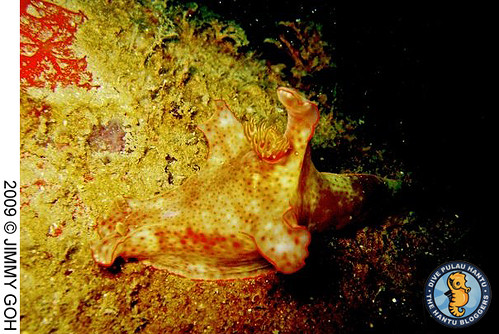
Last Sunday, a full boat of veteran and brand new divers to local waters, took to the sea with the Hantu Blog dive guides. Despite the onset of the monsoons, the weathered stayed fair and sunny all through the day. Reportedly, the underwater visibility was also very accommodating, which made the first dive into Singapore waters for some first timers a little more comfortable! I might give a huge Thank You to volunteer dive instructor Jimmy Goh for once again sharing his experience of Pulau Hantu with us by taking the effort to take these wonderful photographs while guiding newbie divers (it’s a big effort!). Jimmy’s photos have been featured on the blog several times, and have received a lot of positive comment from our readers. So to his favour I have to admit that if you’re wondering why the pictures in this post look a little different from his pictures in earlier posts, it’s because he’s using my camera, which is an inferior model to his! (Above: Slender Ceratosoma nudibranch)
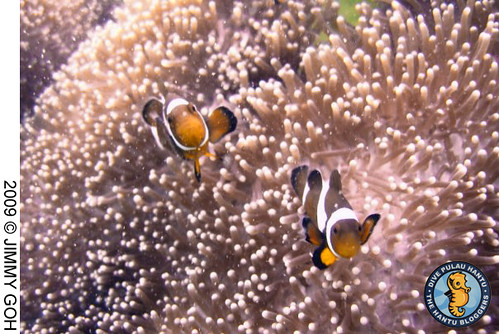
What’s funny about Jimmy and the Ceratosoma nudibranch is that although he’s been diving local waters for more than half a decade now, he only finally saw these unique sea slugs recently. They’ve always managed to elude him. Though you’d think a creature such as this would stand out on the reef, it does infact resemble a sponge when you’re looking at it underwater. (Above: False clown anemonefish)
Little critters need big eyes to spot! Phyllidia sea slugs (above left and center) can grow up to palm-sized adults, they start out as little crawling slugs, or, depending on the species, into tinsy tiny larve that float about in the water (veliger, or planktonic larve) until they eventually grow the body parts they need to hold on to the reef and feed themselves. The center photo shows a young slug that is still relatively “2-dimensional” resting or feeding on a leaf of sargassum seaweed. As they get older their bodies develop into the more “3-dimensional” body shape that you see in the adults (above left). Take note that the two slugs in the above row are not the same species. (Above right: Allied cowrie on coral whip)
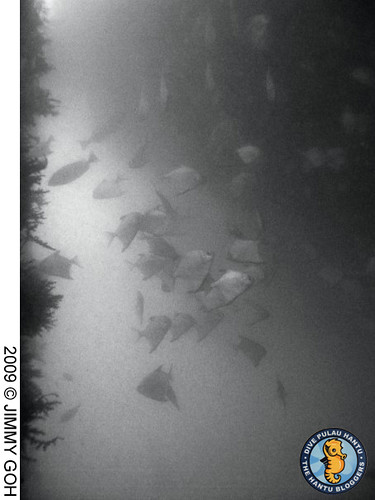
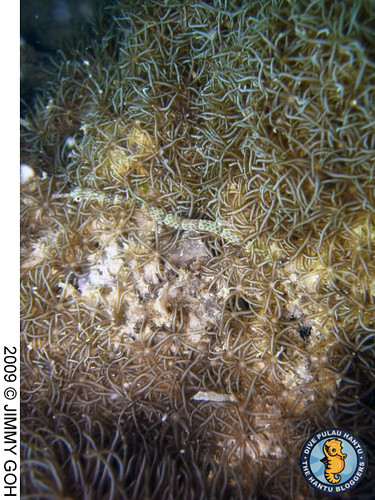
Jimmy manages to take a mood shot of a school of Silver moonies (above left). If you look closely you might also spot some rabbitfish! These Silver moonies began their life journeys as juveniles that live in brackish water (mix of salt and freshwater, usually near mangroves). Silver moonies are shoaling fish that need to be in groups of at least three. Although this is a black and white pictures, going by their name you can sort of guess their colour – they’re silver! Their dorsal fins have a yellow/blackfish tinge. They swim really fast and when you’re in the middle of a school as their swimming from one point of the reef to another, it can be an exhilarating experience! They’re also known as Diamond fish for Silver batfish. As you might be able to tell from the photo above, these fish are vertically flattened (unlike stingrays for example which are horizontally flattened). This physical attribute is what gives them their latin name Monodactylus argenteus. Being really flat, from the front, the fish looks like a stick! ‘Mono’ means ‘one’ and ‘daktylos’ means ‘finger’. Source: Wildfacts
Although Jimmy didn’t manage to get any photos of seahorses this weekend, he did manage to surface with at least one picture of a Syngnathid, like this very well camouflaged rubble pipefish!
Related links: Regular Hantu Blog diver joined us for this dive! Read her blog!
More photos at the Hantu Blog Gallery
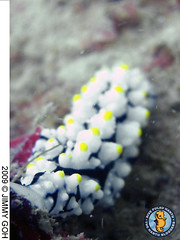


 Posted in
Posted in 



 content rss
content rss
December 9th, 2009 at 8:09 pm
another highlight is that marcell spotted a stonefish and an octopus at the jetty… 🙂